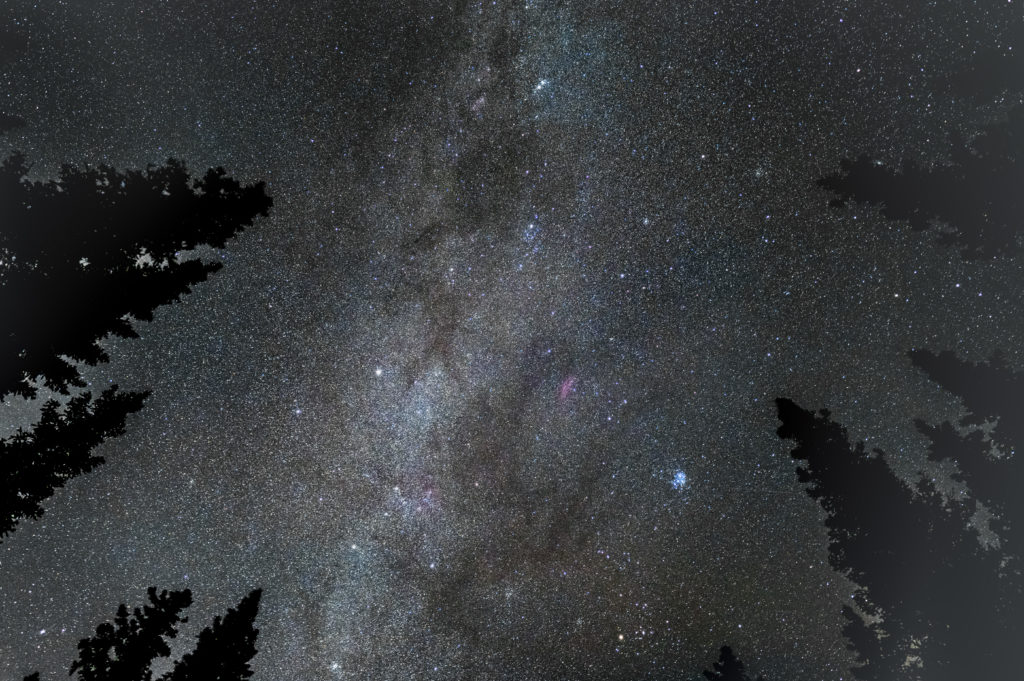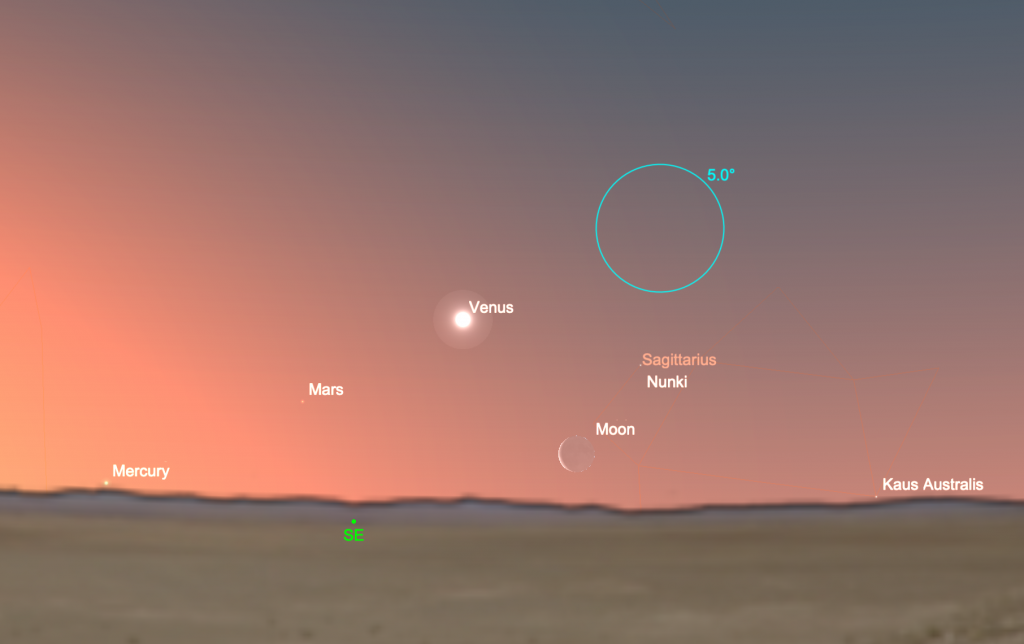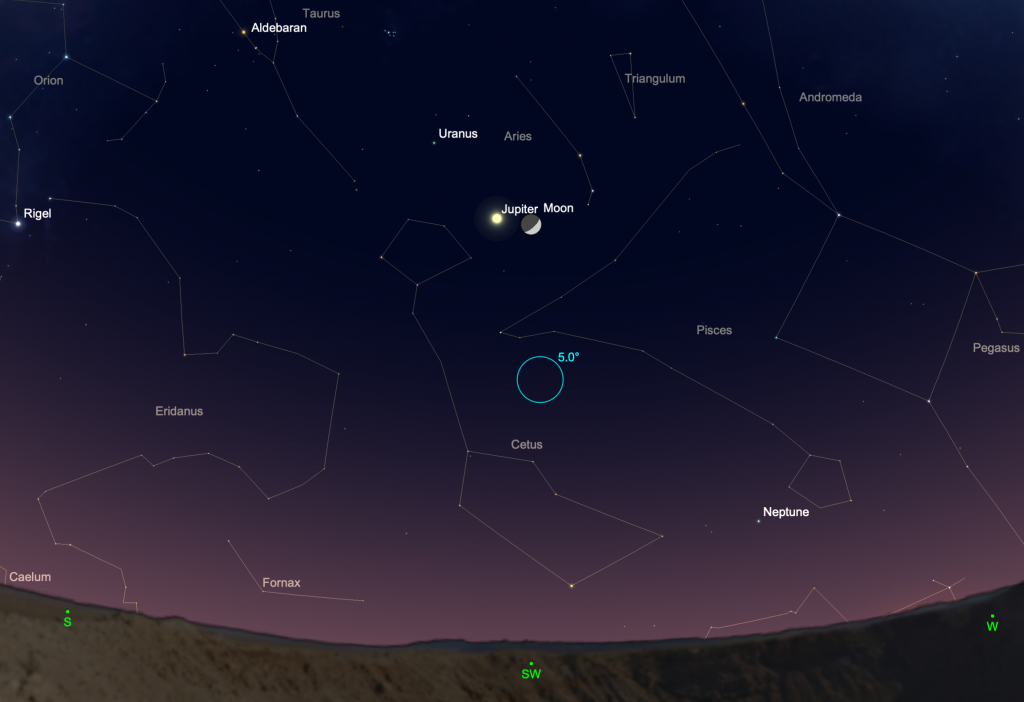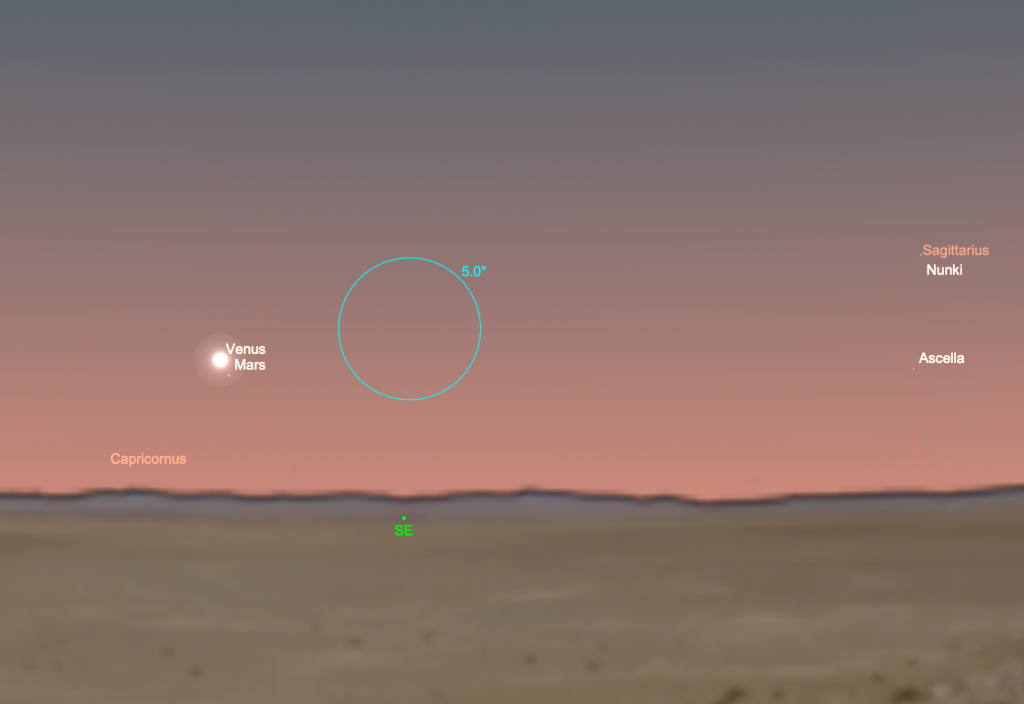
(Looking for last month’s ‘Night Sky’? Find it at this link…)
The constellations Orion, Canis Major, Taurus, Perseus, and Auriga dominate the northern sky this month, while southern observers see these same star groups along with the constellations Puppis, Carina, and Vela which harbor some of the best sights the night sky has to offer. There are plenty of planets to see this February, with Jupiter and Saturn in the western evening sky and Mars and Venus in the eastern early-morning sky. Near the end of the month, you get a chance to glimpse the glow of the zodiacal light, the Sun’s light reflected off tiny grains of dust left over from the formation of the solar system. And there’s an extra day this month – a Leap Day – that helps our calendar stay synchronized to the apparent motion of the Sun and stars. Use your extra day wisely, and try to include in it a little stargazing if you can! Here’s what to see in the night sky this month…
1 February 2024. The month begins with a waning gibbous Moon near the 1st-magnitude star Spica in the southeastern sky before sunrise. Spica lies as close as 1.7º south of the Moon.
2 Feb. Last Quarter Moon, 23:18 UT
5 Feb. The Moon, now a waning crescent, continues its perpetual trip eastward along the ecliptic and today lies a little under 6o east of the bright red supergiant Antares in the constellation Scorpius.

7 Feb. Set your alarm early so you can see a slender crescent Moon, brilliant Venus, and ochre Mars in the southeastern sky before sunrise. The pair form a small triangle about 7o on a side. Binoculars gives you a better view. You will need a good clear view of the horizon to spot this celestial arrangement; southern-hemisphere observers see the Moon and two planets further above the horizon than northern observers.
9 Feb. New Moon, 22:59 UT
10 Feb. Saturn lies about 1.8o north of a very slender crescent Moon in the southwestern evening sky. The two lie very low over the horizon so bring a pair of binoculars to spot this conjunction.

14 Feb. The crescent Moon, now waxing in the western sky, lies about 4o from Jupiter in the southwest near the head of the constellation Cetus, the Whale. As the evening wears on, you can see the pair grow slightly closer to each other before they set just after midnight. Jupiter has faded to magnitude -2.2 with an apparent diameter of 37”. But it’s still big enough for pleasant telescopic observation in the deep-blue twilight sky of a late northern winter.
16 Feb. First Quarter Moon, 15:01 UT
16 Feb. The first quarter Moon lies nearly 4o east of the Pleiades star cluster.
20 Feb. The thickening gibbous Moon lies about 1.5o from Pollux in Gemini high in the evening sky. If you’re out with a telescope, have a look at the other ‘twin’, the star Castor. It’s an excellent double star with a primary of magnitude 1.5 separated by 5.2” from a 3rd-magnitude secondary. Not sure which twin is which? Pollux shines with a yellow light compared to Castor’s icy white. Or as I try to remember it – Castor is closer to Capella (the brightest star in Auriga).

22 Feb. Don’t miss this one – Venus and Mars lie just half a degree apart in the southeastern sky before sunrise. The brightening twilight and low altitude over the horizon mean you will need a pair of binoculars or a small telescope to see this lovely conjunction. The conjunction favors southern-hemisphere observers who see the pair further above the horizon than northerners. At magnitude -3.9, Venus outshines Mars by a factor of 100, so the latter planet will be the hardest to see.
23 Feb. The nearly-full Moon trails the star Regulus in Leo by about 3.5o as they both rise in the evening sky.
24 Feb. Full Moon, 12:30 UT
26 Feb. As the Moon moves out of the way in the evening sky, northern observers far from city lights can spot the zodiacal light in the western sky after sunset. This whitish wedge-shaped glow emerges at a steep angle to the western horizon this time of year. It’s caused by sunlight reflected by fine dust grains along the plane of the solar system. The zodiacal light is brightest closer to the Sun, so look for it about half an hour after the end of evening twilight as it extends up from the horizon towards the constellation Taurus.
28 Feb. The waning gibbous Moon and Spica make another close approach in the southeastern morning sky, just as they did earlier in the month. They will not be quite as close as on Feb. 1.
28 Feb. Saturn reaches conjunction with the Sun. It will reappear in the morning sky in a couple of weeks and start working its way back around the sky for the rest of the year.
29 Feb. Today is a ‘Leap Day’, an extra day added to the calendar at the end of February every four years. Our standard calendar has 365 days, but it takes the earth about 365.25 days to revolve around the Sun. The extra day every four years helps our calendar stay in sync with the mechanics of the solar system. The extra day is not added on ‘century years’ that cannot be evenly divided by 400. So 2000 and 1600 were leap years, but 1700 and 1900 were not.